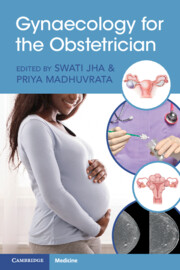Book contents
- Gynaecology for the Obstetrician
- Gynaecology for the Obstetrician
- Copyright page
- Dedication
- Contents
- Contributors
- Foreword
- Preface
- Chapter 1 Ovarian Cysts in Pregnancy
- Chapter 2 Fibroids in Pregnancy
- Chapter 3 Cervical Abnormalities in Pregnancy
- Chapter 4 Vulval Disorders in Pregnancy
- Chapter 5 Congenital Uterine Malformations and Vaginal Anomalies
- Chapter 6 Vaginal Prolapse and Previous Prolapse Surgery
- Chapter 7 Urinary Tract Problems in Pregnancy
- Chapter 8 Previous Third and Fourth Degree Tears
- Chapter 9 Management of Post-Partum Retained Placental Remnants
- Chapter 10 Gestational Trophoblastic Disease (GTD)
- Chapter 11 Female Genital Mutilation
- Chapter 12 Ovarian and Cervical Malignancy in Pregnancy
- Chapter 13 Post-Partum Contraception
- Chapter 14 Pregnancy Associated Breast Cancer
- Index
- References
Chapter 3 - Cervical Abnormalities in Pregnancy
Published online by Cambridge University Press: 14 July 2023
- Gynaecology for the Obstetrician
- Gynaecology for the Obstetrician
- Copyright page
- Dedication
- Contents
- Contributors
- Foreword
- Preface
- Chapter 1 Ovarian Cysts in Pregnancy
- Chapter 2 Fibroids in Pregnancy
- Chapter 3 Cervical Abnormalities in Pregnancy
- Chapter 4 Vulval Disorders in Pregnancy
- Chapter 5 Congenital Uterine Malformations and Vaginal Anomalies
- Chapter 6 Vaginal Prolapse and Previous Prolapse Surgery
- Chapter 7 Urinary Tract Problems in Pregnancy
- Chapter 8 Previous Third and Fourth Degree Tears
- Chapter 9 Management of Post-Partum Retained Placental Remnants
- Chapter 10 Gestational Trophoblastic Disease (GTD)
- Chapter 11 Female Genital Mutilation
- Chapter 12 Ovarian and Cervical Malignancy in Pregnancy
- Chapter 13 Post-Partum Contraception
- Chapter 14 Pregnancy Associated Breast Cancer
- Index
- References
Summary
Conservative management of high-grade pre-invasive disease of the cervix (CIN2–3 ) during pregnancy is acceptable. However, persistent high-risk HPV infection is a major risk factor for CIN2+ persistence. Close follow-up with HPV testing, and antenatal and post-partum colposcopic evaluation including directed biopsies are necessary. However, women who have undergone excisional treatment for CIN2 and above have an increased risk of preterm delivery and preterm rupture of membranes (PROM). Smoking is an important impact factor that could change the vaginal environment influencing the viral load. Treated patients should be informed about increased risk of preterm births and clinicians should offer the most appropriate treatment to optimise the chances of a healthy pregnancy without compromising women’s treatment options. In women diagnosed with invasive cervical cancer in pregnancy, the option of neoadjuvant chemotherapy (NACT) as a means of reaching fetal maturity versus termination followed by definitive management should be offered to the patient.
Keywords
- Type
- Chapter
- Information
- Gynaecology for the Obstetrician , pp. 23 - 30Publisher: Cambridge University PressPrint publication year: 2023



